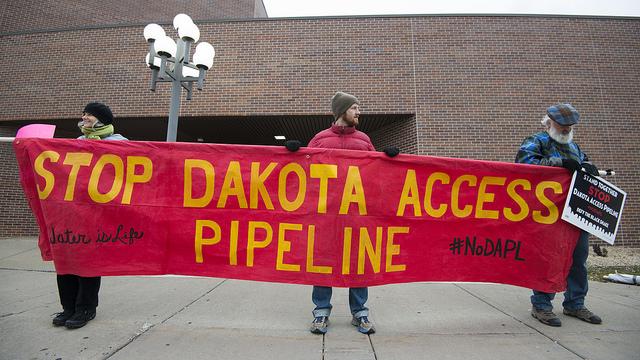Dakota Access Pipeline
Photo by Fibonacci Blue, published on December 1, 2016, some rights reserved, license link: https://creativecommons.org/licenses/by-sa/3.0/legalcode, original link to work: https://www.flickr.com/photos/fibonacciblue/30539932444/in/photolist-c6WkaU-PE4FcE-PdMqvL-Ny21Mn-NwLVfA-PJcbEJ-PMmK1t-PdKyN1-PBcbLn-NwH8Vo-NLucGu-NSyCWq-NAdvkC-N61cqS-N61boS-N61aLE-MHjVZ4-NsSwxm-MBkftq-NoMmDY-Nz6PuD-NoK15L-Nz4pVD-MBg5pq-NoHJCf-NrgFck-NvNEMS-NreMJc-MVG3HD-LKZ2cA-M2KHMh-M5ntFB-M2JwwU-M5m4QH-M2HWC1-LKPBx9-M9nT6d-M5jUm4-M9mQXh-Mcv15a-M2FGtU-Lf7DbE-LKLCiJ-M2E6so-LbDUK7-LbPHER-LJg7iu-LrrLn7-J9ooe5-K1UtjB.
Protesters stand in front of the US bank with a sign displaying their discontent for the pipeline in South Minneapolis.
The Dakota Access Pipeline project is an approximate 1,172-mile and 30-inch diameter pipeline that will run through four states (Illinois, Iowa, North Dakota and South Dakota) that began construction in the third quarter of this year. It is approximated to transport 470,000 barrels a day, with an aim of improving the efficiency of transporting oil from North Dakota to other refineries. The basis of the pipeline is to meet consumer needs for the country to achieve independence in oil quotas.
The pipeline has caused a lot of controversy since its inception. The Standing Rock Sioux tribe has specific concerns: “[the pipeline] threatens the Tribe’s environmental and economic well-being, and would damage and destroy sites of great historic, religious, and cultural significance to the Tribe.” The pipeline poses cultural and environmental concerns, as it will run under the Missouri River which could contaminate the drinking supply of local communities.
After the approval of the pipeline in July by the U.S. Army Corps of Engineers, the Sioux tribe responded with a suit against them. The pipeline offers both pros and cons for the future. It will improve America’s independence on fossil fuels, but with that, America will have an even bigger reliance on non-renewable energy in a time where global warming is ever prevalent and renewable energy is of utmost importance and at the peak of innovation. There is also a risk of greenhouse gas emissions.
Due to these concerns, peaceful protesting has gained momentum with people from around the globe, prompting a call to action with the police and the national guard to preserve order. Last week, police were met with “very aggressive” action from approximately 400 protesters. Police responded with firing of rubber bullets, tear gas, and water at the crowd, resulting in a violent clash. Police were there to prevent protesters from crossing a bridge damaged by arson on October 27th and to prevent trespassing onto the U.S. Army Corps of Engineers’ land.
The Governor of North Dakota released a statement that “[they] will not forcibly remove protesters,” but urges protesters to leave immediately due to the incoming cold conditions. The cold has not stopped the protesters from leaving their camps, and now they’re about to get more support from 2,000 veterans from “Veterans from Veterans Stand for Standing Rock,” created by Wesley Clark. The organization called to all members to stand with Standing Rock on Saturday the third- before Sunday when all protesters must leave or face arrest.
Since the protests inception, more than 525 protesters have been arrested.
Fortunately for protesters, the Army Corps of Engineers released a statement on the 4th of December to reroute the pipeline away from the Standing Rock reservation.
Your donation will help support The Lambert Post, Lambert High Schools student-run newspaper! Your contribution will allow us to purchase equipment and cover website hosting costs.










